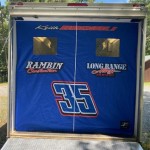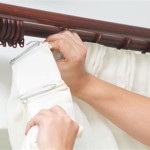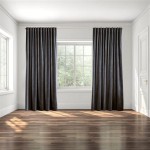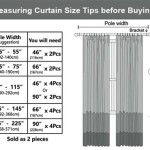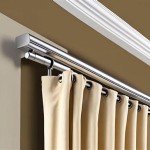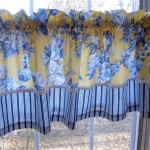Heavy Duty Curtain Tension Rods: A Comprehensive Guide
Heavy duty curtain tension rods provide a versatile and damage-free solution for hanging curtains in a variety of locations. Unlike traditional curtain rods that require drilling and mounting hardware, tension rods rely on spring tension or pressure to remain securely in place. This makes them ideal for renters, individuals seeking temporary window coverings, or those who prefer to avoid making permanent alterations to their walls and window frames. However, not all tension rods are created equal. Heavy duty models are specifically designed to support heavier fabrics and larger curtains, offering a more stable and reliable option compared to standard tension rods.
The construction and materials used in heavy duty curtain tension rods are significantly stronger than those found in lighter-duty versions. This robustness translates to an improved ability to handle weight without sagging, slipping, or collapsing. Understanding the key features, applications, and considerations when selecting a heavy duty tension rod is crucial for ensuring a successful and lasting installation.
Key Features of Heavy Duty Curtain Tension Rods
Several features distinguish heavy duty curtain tension rods from their standard counterparts. These features contribute to their increased strength, stability, and overall performance.
Material Strength: Heavy duty tension rods are typically constructed from high-quality materials such as stainless steel, heavy-gauge steel, or reinforced aluminum. These materials offer superior resistance to bending, corrosion, and wear. The thicker gauge of the metal contributes significantly to the rod's weight-bearing capacity. Lower-quality rods often use thinner, less durable materials that are prone to bending or breaking under the weight of heavier curtains.
Diameter and Wall Thickness: The diameter of the rod itself and the thickness of its walls are critical factors in determining its strength. A larger diameter and thicker walls provide greater resistance to bending and deflection. Heavy duty rods typically have a larger diameter than standard rods, and their walls are significantly thicker. This increased mass contributes to the rod's ability to support heavier curtains without sagging.
Tension Mechanism: The tension mechanism is responsible for creating the force that holds the rod in place. Heavy duty rods often employ more robust tension mechanisms, such as a heavy-duty spring or a secure locking system. Some models feature a ratcheting mechanism that allows for precise adjustments and increased stability. The quality and design of the tension mechanism directly impact the rod's ability to maintain a consistent and reliable grip on the mounting surface.
End Caps and Mounting Plates: The end caps and mounting plates are the points of contact between the rod and the wall or window frame. In heavy duty models, these components are often made from durable materials like rubber or reinforced plastic. They are designed to provide a secure and non-slip grip, preventing the rod from sliding or damaging the mounting surface. The surface area of the end caps and mounting plates also plays a role in distributing the weight of the curtains evenly, reducing the risk of slippage or wall damage.
Weight Capacity: A crucial specification for any curtain rod is its weight capacity. Heavy duty tension rods are designed to support significantly more weight than standard models. The weight capacity is typically specified by the manufacturer and should be carefully considered based on the weight of the curtains being hung. Exceeding the weight capacity can lead to sagging, slippage, or even complete failure of the rod. It's always advisable to choose a rod with a weight capacity that exceeds the actual weight of the curtains to provide a safety margin.
Applications for Heavy Duty Curtain Tension Rods
The increased strength and stability of heavy duty curtain tension rods make them suitable for a wide range of applications, particularly those involving heavier fabrics or unconventional window sizes.
Heavy Curtains and Drapes: Heavy duty rods are specifically designed to support the weight of heavy curtains and drapes made from materials such as velvet, blackout lining, or multiple layers of fabric. These materials can be significantly heavier than lighter fabrics like voile or cotton, requiring a robust rod to prevent sagging or failure. They are capable of supporting these visually appealing curtains while maintaining its structural integrity.
Room Dividers: Tension rods can be used to create temporary room dividers in apartments, studios, or shared living spaces. Heavy duty rods are particularly well-suited for this application, as they can support heavier fabrics or even lightweight panels to create a more substantial and private partition. The ability to hang heavier materials provides greater flexibility in designing the room divider and achieving the desired level of privacy.
Shower Curtains: While standard tension rods are often used for shower curtains, heavy duty models offer a more secure and reliable option, especially for heavier shower curtains or shower curtains with liners. The increased weight capacity and stability of heavy duty rods prevent sagging and ensure that the curtain remains securely in place, even when wet. They are especially useful in situations where the shower walls are not perfectly smooth or if there is a significant distance to span.
Large Windows: For wider windows or patio doors, heavy duty tension rods provide the necessary support to hang curtains without sagging in the middle. Standard tension rods may not be long enough or strong enough to span the width of a large window without bending under the weight of the curtains. Heavy duty models are available in longer lengths and with increased weight capacities to accommodate these larger openings.
Garages and Workshops: Heavy duty tension rods can be used in garages and workshops to create temporary storage solutions or to hang heavy items. They can be used to hang tools, equipment, or even tarps to create a temporary workspace. The ability to securely support heavier loads makes them a versatile and convenient option for organizing and utilizing space in these environments.
Considerations When Selecting and Installing Heavy Duty Tension Rods
Choosing the right heavy duty curtain tension rod and installing it correctly is essential for ensuring its performance and longevity. Several factors should be considered during the selection and installation process.
Measuring the Space: Accurate measurement of the space where the rod will be installed is crucial. Measure the distance between the mounting surfaces at the desired height. Choose a rod that is slightly longer than the measured distance to allow for proper tensioning. Many tension rods are adjustable, providing a range of lengths to accommodate different spaces. Refer to the manufacturer's specifications to ensure that the selected rod fits within the intended range.
Weight Capacity: Determine the weight of the curtains or other items that will be hung on the rod. Choose a rod with a weight capacity that exceeds the estimated weight by a reasonable margin. This provides a safety factor and helps prevent sagging or failure. Consider the weight of any additional hardware, such as curtain rings or hooks, when calculating the total weight.
Surface Compatibility: Ensure that the end caps or mounting plates of the rod are compatible with the mounting surfaces. Smooth, non-porous surfaces such as tile or glass provide the best grip. For textured or porous surfaces, consider using mounting plates with a larger surface area or adding adhesive pads to enhance the grip. Avoid installing tension rods on fragile surfaces that could be damaged by the pressure.
Installation Technique: Follow the manufacturer's instructions carefully when installing the tension rod. Typically, this involves extending the rod slightly beyond the measured distance, compressing the spring or locking mechanism, and then carefully positioning the rod between the mounting surfaces. Ensure that the rod is level and securely in place before hanging the curtains. Periodically check the rod for slippage or sagging and readjust if necessary.
Finish and Aesthetics: Heavy duty tension rods are available in a variety of finishes to complement different décor styles. Consider the overall aesthetic of the room and choose a rod with a finish that blends in or provides a visual accent. Common finishes include chrome, brushed nickel, black, and white. The visibility of the rod can be minimized by choosing a finish that matches the color of the walls or window frame.
Maintenance: Regularly inspect the tension rod for signs of wear or damage. Clean the rod and end caps periodically to remove dust and debris. If the rod begins to sag or slip, readjust the tension or consider replacing it with a new one. Proper maintenance can extend the lifespan of the rod and ensure its continued performance.
By carefully considering these factors and selecting a high-quality heavy duty curtain tension rod, individuals can enjoy the benefits of a secure, damage-free, and versatile window covering solution.

Tension Curtain Rod Window Bedroom Kitchen Long Heavy Duty Wal Com

1 No Drilling Shower Closet Window Tension Rod Heavy Duty 42 72 Matte Black Wal Com

Roomdividersnow 120 In 150 Premium Tension Curtain Rod Silver Ptrod Slvr150n The Home

Roomdividersnow 80 In 120 Premium Tension Curtain Rod Silver Trod Slvr144 The Home

Heavy Duty Tension Curtain Rod For Window 82 121 Inch Room Divider With Adjustable Pole Patio Bedroom Balcony Hold Up Blackout Curtains And Non Slip Solid Black Wal Com

2pcs Heavy Duty Tension Rods 23in To 43in Adjustable Non Slip Shower Curtain Rod

Roomdividersnow 120 In 150 Premium Tension Curtain Rod Black Ptrod Bl150n The Home

Premium Room Divider Tension Curtain Rod Save Upto 30 Roomdividersnow

Heavy Duty Steel Tension Curtain Rod Spring Load Adjustable Pole 23 034 43

Heavy Duty Telescopic Tension Rod


